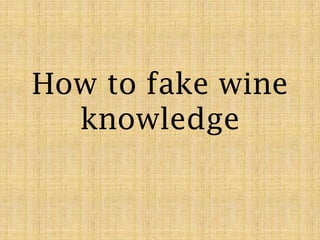How to fake wine knowledge
- 1. How to fake wine knowledge
- 2. 10. Body Language A major component to any con is being convincing. Pick that wine list off the table or grab that bottle off the shelf and start looking it over confidently.
- 3. 9. Lingo ŌĆó Aroma=the smell ŌĆó Acidity/Acidic=tartness. Think lemon, lime, grapefruit, blueberries. and cranberries. ŌĆó Dry=Not sweet. Sometimes on bottles of champagne and sparkling wine youŌĆÖll see the word ŌĆ£Brut;ŌĆØ it means the same thing. ŌĆó Tannin(s)/Tannic=astringency. If youŌĆÖve ever had a cup of tea that steeped too long, then you know what tannins are. ŌĆó Vintage=the year that grapes were harvested. As in ŌĆ£2005 was a great vintage.ŌĆØ ŌĆó Balance=the overall unity of the flavors.
- 4. 8. Opt to Decant If youŌĆÖre part of a large group and wine is flowing freely, skip this step. But in almost every other scenario, decanting is rarely a bad idea. Most wines improve as they are exposed to air, which is why you do all of that swirling and slurping. Decanting, the act of transferring the wine from its original bottle into another vessel before serving, helps expedite this process. ItŌĆÖs less common to decant white wine.
- 5. 7. Interact with your glass When you first receive a glass, hold it by the stem, tilt it away from you, and observe the color of the wine. Gently swirl the wine in the glass by making small circles with you wrist; be careful not to overdo this motion and end up spilling wine. If anyone asks why you're doing this, tell them itŌĆÖs to help the wine open up. Take a small sip of the wine, and while holding it in your mouth, gently suck in a bit of air. This action will make a slight slurping soundŌĆöthis is done to pass more air through the wine helping it to release more of its flavors. You donŌĆÖt have to do this with every sip, but you should do it with the first.
- 6. 6. Know random facts Bring a bottle of Cr├®mant de Bourgogne Blanc de Blanc to a party and explain that while itŌĆÖs made the same way as Champagne and uses one of the grapes found in Champagne, because itŌĆÖs from a different region itŌĆÖs classified Cr├®mant. You need to have a few of these up your sleeves, lest you come off as a one trick pony.
- 7. 5. Judge a Book By Its Cover (To a Degree) If you happen to be in a situation where you can see the bottle youŌĆÖre drinking from (or about to drink from); you can make some snap judgments on the label alone. For example, if the bottle that youŌĆÖre about to drink has a black and white label with a drawing of a grape cluster and cursive writing, you could comment on how the wine is fruity yet traditional. On the other hand, if the label is colorful with an animal image on it, the wine might be fun or easy to drink. Or, if thereŌĆÖs calligraphic writing and a coat of arms on the label, you could assume (and announce) that's it's serious and traditional.
- 8. 4. If You CanŌĆÖt Pronounce It, DonŌĆÖt Order It This is a surefire way to show that you donŌĆÖt know what youŌĆÖre ordering. Amongst the many reasons why Merlot, Malbec, and Chardonnay are more popular than Falanghina or Blaufr├żnkish is the ease of pronouncing the names.
- 9. 3. Steal By persuading another (especially someone who is particularly versed with wine) to start a dialogue, you can take their commentary and improve on it. By agreeing with someoneŌĆÖs opinion and expanding on it, now officially making it your opinion, that very person is more inclined to agree with you and endorse your ŌĆ£wine expertise.ŌĆØ
- 10. 2. Consider the Situation at Hand Are you surrounded by a group of wine savvy people, or is it just one or two? Better yet, are you around people that donŌĆÖt know much about wine? The more knowledgeable your company is, the more you want them to talk, giving you the opportunity to reshape their commentary.
- 11. 1. Keep Something in the Tank DonŌĆÖt use every wine term you learned, name every grape you can think of, and voice your three bits of esoteric information in the first five minutes. This will make you appear like youŌĆÖre scrambling to look knowledgeable. Instead, give a little and take a little, but keep something in reserve.











